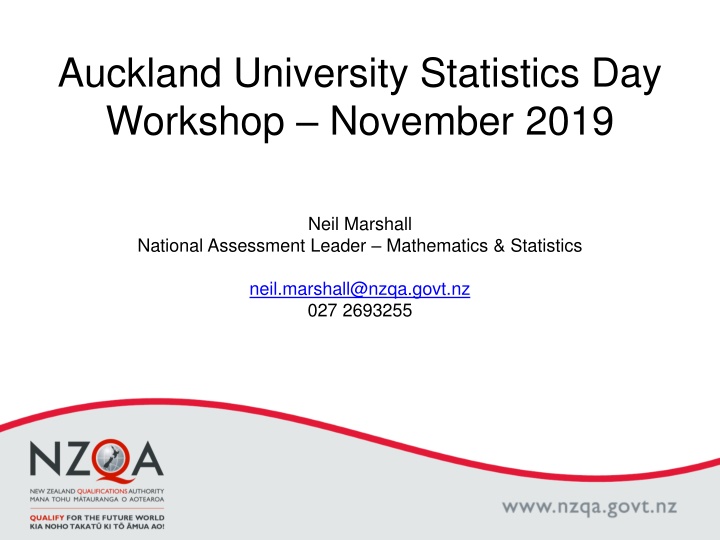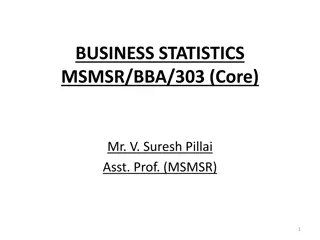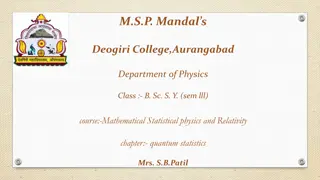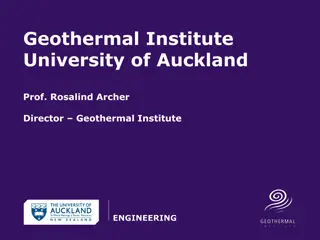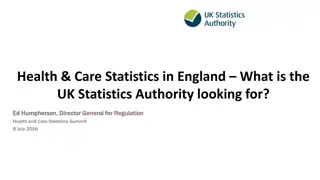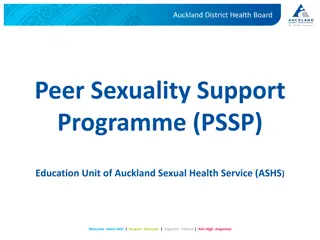Auckland University Statistics Workshop for Teachers
In November 2019, Neil Marshall organized a Statistics Day Workshop at Auckland University to support teachers new to NCEA in making accurate judgements for statistics Achievement Standards. The workshop focused on Level 1 AS but was relevant for Levels 2 and 3 as well. Resources and guides for secondary teaching and learning in Mathematics and Statistics were provided, along with information on NZQA's Mathematics levels. Specific Achievement Standards like 91035, 91036, and 91038 were discussed, along with the statistical enquiry cycle and the experimental process outlined in Explanatory Note 3. Students were guided on investigating multivariate data sets, bivariate numerical data, and situations involving chance, emphasizing data analysis, interpretation, and communication of findings.
Download Presentation

Please find below an Image/Link to download the presentation.
The content on the website is provided AS IS for your information and personal use only. It may not be sold, licensed, or shared on other websites without obtaining consent from the author.If you encounter any issues during the download, it is possible that the publisher has removed the file from their server.
You are allowed to download the files provided on this website for personal or commercial use, subject to the condition that they are used lawfully. All files are the property of their respective owners.
The content on the website is provided AS IS for your information and personal use only. It may not be sold, licensed, or shared on other websites without obtaining consent from the author.
E N D
Presentation Transcript
Auckland University Statistics Day Workshop November 2019 Neil Marshall National Assessment Leader Mathematics & Statistics neil.marshall@nzqa.govt.nz 027 2693255
Objectives 1. To support teachers who are new to NCEA to make sound judgements at all levels of achievement for the statistics Achievement Standards. The focus will be on the Level 1 AS, but the messages apply equally to Levels 2 and 3. 2. General messages about moderation.
Secondary teaching and Learning Guides http://seniorsecondary.tki.org.nz/Mathematics-and-statistics
NZQA landing page https://www.nzqa.govt.nz/ncea/subjects/mathematics/levels/
Achieved 91035 Investigate a given multivariate data set using the statistical enquiry cycle. Using the statistical enquiry cycle involves using each component of the statistical enquiry cycle to make comparisons. 91036 Investigate bivariate numerical data using the statistical enquiry cycle. Using the statistical enquiry cycle involves using each component of the statistical enquiry cycle to investigate bivariate numerical data. 91038 Investigate a situation involving elements of chance. Investigate a situation involves using the experimental probability process.
The statistical enquiry cycle & The experimental process are outlined in Explanatory note 3 91035 Students need to be familiar with the statistical enquiry cycle to investigate a given multivariate data set, which involves: investigating data that has been collected from a survey situation posing an appropriate comparison question using a given multivariate data set selecting and using appropriate display(s) giving summary statistics such as the five summary values (minimum, maximum, median, quartiles) discussing features of distributions comparatively, such as shape, middle 50%, shift, overlap, spread, unusual or interesting features communicating findings, such as informal inference and supporting evidence, in a conclusion.
The statistical enquiry cycle and The experimental process are outlined in Explanatory Note 3 91036 Students need to be familiar with using the statistical enquiry cycle to investigate bivariate numerical data, which involves: planning and conducting an investigation using bivariate numerical data working with a given relationship question determining appropriate variables and measures managing sources of variation gathering data selecting and using appropriate display(s) communicating relationship(s) in the data in a conclusion.
The statistical enquiry cycle and The experimental process are outlined in Explanatory Note 3 91038 Students need to be familiar with the process of experimental probability, which involves: posing a question to explore a situation involving elements of chance planning an experiment to explore the situation (discussing and defining the set of possible outcomes and deciding the sample size) gathering data by performing the experiment selecting and using appropriate displays including experimental probability distributions identifying and communicating patterns in the data comparing discrete theoretical distributions and experimental distributions as appropriate communicating findings in a conclusion.
Merit 91035 Using the statistical enquiry cycle with justification involves linking aspects of the statistical enquiry cycle to the context and the population and making supporting statements which refer to evidence such as summary statistics, data values, trends or features of visual displays. 91036 Using the statistical enquiry cycle with justification involves linking aspects of the statistical enquiry cycle to the context and making supporting statements which refer to evidence such as summary statistics, data values, trends or features of visual displays. 91038 Investigate, with justification involves linking aspects of the investigation to the situation and making supporting statements which refer to evidence such as summary statistics, probabilities, trends or features of visual displays.
Excellence 91035 Using the statistical enquiry cycle with statistical insight involves integrating statistical and contextual knowledge throughout the statistical enquiry cycle, and may involve reflecting on the process or considering other explanations for the findings. 91036 Using the statistical enquiry cycle with statistical insight involves integrating statistical and contextual knowledge throughout the statistical enquiry cycle, and may involve reflecting on the process or considering other explanations for the findings. 91038 Investigate, showing statistical insight involves integrating contextual information and knowledge with an understanding of applications of probability and may involve considering the possible effects of other related variables or factors.
Common messages The big idea telling stories that we see in the data. Students look at the displays and tell us what they see (Achieved). Students justify these statements using the summary statistics, features of the displays and link the statements fully to the context (Merit). Students show insight by linking these justified statements to the context and integrating contextual knowledge (Excellence). Level 1: the contextual knowledge is intuitive because the students are very familiar with the context. Level 2: the context is less familiar and the activity provides appropriate contextual knowledge. Level 3: the context is unfamiliar and students conduct research to gain their contextual knowledge.
Making judgements - holistically Every bullet point of Explanatory Note 3 needs to be ticked off for every level of achievement. The evidence may not be where you expect it so look across the whole script. The evidence will not be of the same quality for each bullet point so once they are all ticked off, step back and make a holistic call as to whether to give an E, an M or an A. There must be justification (for M) and insight (for E) linked to the big idea of the standard. So for the inference standards look for E or M around the inference statement and then some support for elsewhere.
Conditions of Assessment Give you a licence to design the assessment activity in a format which best suits the needs of your students and reflects the teaching and learning environment. Open book, google docs, group work, projects Assessments do not have to be time bound. You do need to assure authenticity.
Clarifications Give you guidance on making sound judgements
Exemplars The exemplars on the NZQA website are designed to help teachers identify the grade boundary. They are not intended to be "models" for students. There is more than one way of getting each level of Achievement the exemplars are a way not the way. Read the annotations carefully. The best exemplars you can use for students are from your own benchmarking folder (examples from your own students, in particular the student work that has been externally moderated). You should get students permission before using their work as exemplars for other students.
Key, reliable, peer reviewed online resources for teaching and assessing statistics Statistics and Data Science Educator https://sdse.online/ Census at School https://new.censusatschool.org.nz/ Teaching Statistics is Awesome https://teaching.statistics-is-awesome.org A teacher s job is to never give up on their students https://drdalrymple.wordpress.com/author/drdalrymple/ Karekare Education http://karekareeducation.co.nz/about/
Moderation The focus of the moderation process is to ensure that student evidence meets the criteria of the standard on a national basis. The moderator will consider if the students evidence meets the requirements of the standard. They will moderate assessor judgments for the student work you submit against the standard, not your mark schedule. They will not moderate your task unless they disagree with your judgements and the task is the reason for the grade disagreement. You can submit a query if the moderation materials have been submitted digitally or physically. You can always appeal (and re-appeal) if you disagree with moderation.
